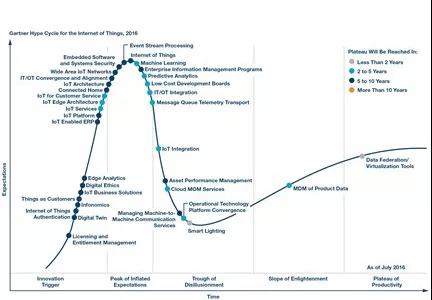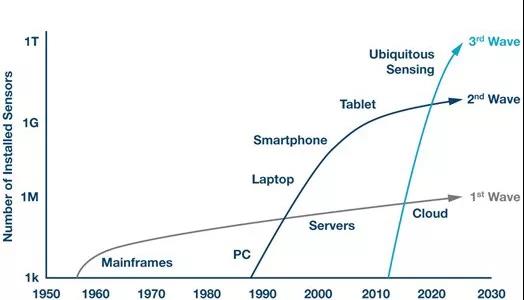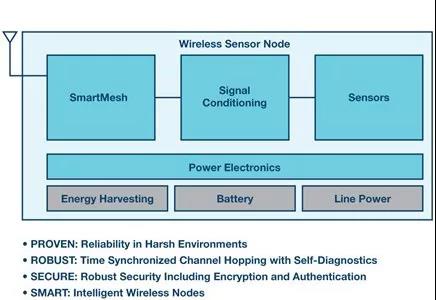What's next for the Internet of things?
The initial technology maturity curve for iot development is only based on an increase in the number of deployed and potential sensors. Today, we can look to the future and explore some important success factors. Future trends in the Internet of things, including iot applications, will bring economic benefits to end users. There is also a trend towards longer battery life, lasting for years. In any wireless iot monitoring system, data transmission consumes power. Therefore, the perception and processing take place at the edge nodes through intelligent partitioning, and the amount of data is reduced (in a more sporadic or shorter period) through local decisions, thus bringing significant added value to the iot system. Finally, the key element of the future is the ability to operate safely and reliably. Therefore, for successful iot systems, the focus of iot design will shift to key performance indicators such as trusted sensors and system uptime. Analysts estimate that low - cost development systems are currently in the Peak of expectation inflation. In the next two to five years, differentiated or specialized high - precision sensors and analog signal chains will become the mainstream and truly push the Internet of things market into the future.


>> importance of good data
A key process in iot systems is the conversion of analog signals into digital signals. Simply put, the better the transformation, the more useful the data. Silicon technology innovates to transform and interpret the world around it, bridging the real and digital worlds through detection, measurement, interpretation, and connectivity.

The most effective iot deployment is the ability to use this data to determine change. And best change is the biggest value for end customer, such as higher efficiency and higher security, such as in factories, machine learning is not only able to identify when may need to machines for predictive maintenance in the future, but also can identify the details and reach a higher level of recognition, to determine what action to take (for example, to identify specific ball bearing in motor wear).
Therefore, the first stage of any iot system is to detect, measure, and then convert real-time signals into analytical data. How well this stage is completed will lay the foundation for future success. If the wrong information data is entered, the results obtained from any iot analysis cloud platform will also be wrong. Therefore, the most successful iot systems have to have measurement and reporting levels that other systems cannot.
This need to improve measurement and reporting makes good hardware essential. A recent Gartner report said the same. Report that they are low cost iot development look fast into the bubble period of disillusionment (trough of disillusionment. This may be due to the plethora of low-cost development platforms available. But I think it's more likely that we're focusing on more challenging iot applications that have more real economic value. These applications rely on data results that rough measurements simply cannot support.
>> partition between iot system nodes and cloud
Cloud technology supports the adoption of extended multiple signal chains, including analytics and big data. Iot applications mainly in edge nodes achieve high intelligence - this is the result of many factors, including the transmission of all data to the cloud bandwidth (or more precisely: error - free transmission of the data transmission rate limit), or delay problem, namely node required action speed means that the system can't waiting for the response returned from the cloud. Therefore, multiple control loops are required on nodes, intermediate gateways, and in the cloud. The cloud is able to consolidate data for a large number of sensors and adjust edge Settings based on that data. McKinsey reckons that only 1% of cloud data is actually used, and that security threats mean it is better to keep data local.

The implementation of intelligent partitioning and embedding algorithm in the sensor can interpret the most critical data at the source in real time. Algorithms embedded in smart sensors and the cloud can read data deeper than silicon chips. In fact, this makes it possible to predict future system behavior. Accelerating the adoption of iot solutions in mission - critical applications depends on the ability to build secure systems, which smart partitioning can do.
Cloud computing draws insights from this connection between a large number of preliminary sensor readings and correlates a variety of different sensor readings based on time, location, and other sensors. This consists of two parts: the ability to detect changes in data (for example, the drift of machine performance) and the ability to create a "digital twin" of a software model of a real object (such as a motor) or system. These digital twins can be used to proactively repair equipment or plan production processes. This is part of the outlook for explosive growth in sensors over the next few years, as well as the ability to monetize software and services.
In industrial automation, active machine monitoring can fundamentally improve uptime efficiency, achieve real - time optimization and intervention locally, and integrate information across multiple factories and systems in the cloud for analysis and response, thus improving productivity.
So smart iot system partitioning can ensure effective utilization of the cloud.
> > reliable data is key
The final piece of what is crucial to the Internet of things is the creation of wireless networks. The vast majority of networked objects are wirelessly connected back to the cloud using radio and microwave frequencies. The operation mode is various, the operation range is from short to long, and the data rate is from low to high. Some devices may not communicate for months or years, while others need to operate across critical business security networks. Many sensor nodes are also powered by batteries or energy collectors, so efficient operation will be key. Communication networks are critical to the transmission of intelligence from sensors to the cloud on demand.

But reliable operation will be the most critical element for the successful implementation of the iot system. All of these different requirements put a lot of emphasis on communication networks for sensor to cloud intelligence delivery. Reliable operational capability is particularly challenging in harsh environments, such as factories built of metal and concrete. What customers need most is low - cost, low - power, low - latency technology. They also want the sensor layout to expand unchecked. Creating a reliable network without relying on wireless protocols is to maintain this high reliability by using alternative paths and channels to overcome interference. Article source website, reprint indicate the source.
